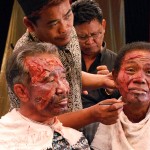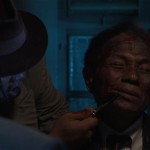Both films, Hannah Arendt and the Act of Killing, are shown next to each other at Opera Plaza Cinemas in San Francisco. If you haven’t seen them, take an afternoon or evening off and go through hell. It will haunt you for days, especially The Act of Killing, a documentary in Werner Herzog’s style ( he is one of the executive producers), where the boundaries between reality and fiction are fluid and boundaries between reality and film become so undistinguishable that at the end I thought, it was a Hollywood movie I had just seen about torture, terror, killings and smiling gangsters who had committed the brutal acts. Inspired by Hollywood movies the killers in Indonesia who, in 1965, after Sukarno was ousted by the military, killed in a year about a million Sukarno supporters by cutting their throats, beating them to death, strangling them with wires (it was less bloody) and to this day have lived almost happily ever after. The government that supported the coup is still in power. The perpetrators, common people, who love to dance and act out, cross dress and boast about the atrocities they committed, have raised children and grand children telling them about their bloody past without feeling any remorse. At the end of the film, one of them (who looks so much like Nelson Mandela!) has stomach convulsions, he bents over in pain and throws up into the trough where he had slaughtered thousands of innocent people. Is it real? Or is it another re-enactment, this time of remorse? Was I supposed to feel any relief, may be even empathy with this brutal killer now that he finally felt some stomach pain? No, I didn’t feel any. I was just wondering when and if he would ever face a court of justice —like Eichmann.
When THE ACT OF KILLING was shown at the Berlinale 2013 people asked Joshua Oppenheimer, the director, if he could imagine making a movie about Nazis (if still alive) re-enacting the Holocaust. There are many similarities, yes. In both cases the unsuspected, common man committed the crimes. Not a monster but a neighbor who, in Indonesia, danced the Cha Cha Cha expertly and loved Hollywood movies. In Germany he might have belonged to a police battalion from Hamburg, a left-leaning working class city that didn’t support the Nazis early on. (See Goldhagen www.
For more on The Act of Killing here some links to the NYT http://www.nytimes.com/2013/
No Bali for me —but I do have a small flat in Berlin.









